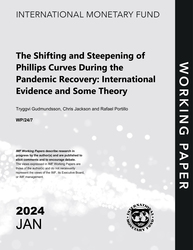
The Shifting and Steepening of Phillips Curves During the Pandemic Recovery: International Evidence and Some Theory
The Shifting and Steepening of Phillips Curves During the Pandemic Recovery: International Evidence and Some Theory
READ MORE...
Volume/Issue:
Volume 2024
Issue 007
Publication date: January 2024
ISBN: 9798400263446
$20.00
Add to Cart by clicking price of the language and format you'd like to purchase
Available Languages and Formats
| English |
Prices in red indicate formats that are not yet available but are forthcoming.
Topics covered in this book
This title contains information about the following subjects.
Click on a subject if you would like to see other titles with the same subjects.
Inflation , Economics- Macroeconomics , Economics / General , Inflation , Phillips Curves , COVID-19 , inflation surge , output-inflation relation , sectoral Phillips curves , inflation response , goods price , Output gap , Business cycles , Economic recession , Global
Summary
We study the global inflation surge during the pandemic recovery and the implications for aggregate and sectoral Phillips curves. We provide evidence that Phillips curves shifted up and steepened across advanced economies, and that differences in the inflation response across sectors imply the relative price of goods has been pro-cyclical this time around rather than a-cyclical as during previous cycles. We show analytically that these three features emerge endogenously in a two-sector new-Keynesian model when we introduce unbalanced recoveries that run against a supply constraint in the goods sector. A calibrated exercise shows that the resulting changes to the output-inflation relation are quantitatively important and improve the model's ability to replicate the inflation surge during this period.
Copyright © 2010 - 2025
Powered by:
AIDC



